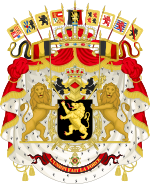Albert I of Belgium
| Albert I | |
|---|---|
| King of the Belgians | |
 | |
| Reign | 23 December, 1909 – 17 February, 1934 (24 years) |
| Predecessor | Leopold II |
| Successor | Leopold III |
| Issue | Leopold Charles Marie-José |
| House | Wettin (Saxe-Coburg and Gotha line) |
| Father | Prince Philippe, Count of Flanders |
| Mother | Princess Marie of Hohenzollern-Sigmaringen |
Albert I (April 8, 1875 – February 17, 1934) was the third King of the Belgians.
Born Albert Léopold Clément Marie Meinrad in Brussels, he was the younger son of Prince Philippe, Count of Flanders, and succeeded his uncle, Leopold II of Belgium, on the throne on December 17, 1909. His grandfather, Leopold I, had been the first King of the Belgians, and his aunt, the first princess of Belgium, was Empress Carlota of Mexico.
He was married on October 2, 1900 to Duchess Elisabeth Gabrielle Valérie Marie in Bavaria, a Wittelsbach princess whom he met at a family funeral. A daughter of Karl-Theodor, Duke in Bavaria, and his wife, the Infanta Maria Josepha of Portugal, she was born at Possenhofen, Bavaria, Germany, on July 25, 1876, and died on November 23, 1965.
Their children
- Léopold Philippe Charles Albert Meinrad Hubertus Marie Miguel, Duke of Brabant, Prince of Belgium, who became later the fourth king of the Belgians as Leopold III, born November 3, 1901, and died at Woluwe-Saint-Lambert on September 25, 1983.
- Charles-Théodore Henri Antoine Meinrad, Count of Flanders, Prince of Belgium, Regent of Belgium, born Brussels October 10, 1903, and died at Ostend on June 1, 1983.
- Marie-José Charlotte Sophie Amélie Henriette Gabrielle, Princess of Belgium, born Ostend August 4, 1906. She was married at Rome, Italy on January 8, 1930 to Prince Umberto Nicola Tommaso Giovanni Maria, Prince of Piemonte, born on September 15, 1904, and died on March 18, 1983 at Geneva, Switzerland. He became King Umberto II of Italy on May 9, 1946. Marie-Jose died January 27, 2001.
King
With the death of his elder brother, Prince Baudouin in 1891 (a 22 year-old bachelor), Albert became third and direct-in-line for the throne. He became Count of Flanders (and heir-presumptive to the Belgian throne), upon the death of his father in 1905. Following the death of his uncle, King Leopold II, in 1909, Albert succeeded to the throne.
At the beginning of World War I, Albert resisted the German advance and held them off long enough for Britain and France to prepare for the Battle of the Marne (6 - 9 September, 1914), famously responding to the German desire to move soldiers through his country, "I rule a nation, not a road!". He led his army through the Siege of Antwerp and the Battle of the Yser and at the end of the war as commander of the Army Group Flanders, consisting of Belgian, British and French divisions, back into its own territory. He re-entered Brussels to a hero's welcome.
King Albert I died in a climbing accident at Marche-les-Dames, in the Ardennes region of Belgium near Namur. He is interred in the Royal vault at the Church of Our Lady, Laeken Cemetery, Brussels, Belgium. His death has caused a great deal of discussion, but rumours of murder are discounted by all serious historians.[citation needed]
 |
| Leopold I |
|---|
|
Children |
| Leopold II |
| Albert I |
| Leopold III |
| Baudouin |
| Albert II |
| Philippe |
In 1935, prominent Belgian author Emile Cammaerts published a widely acclaimed biography of King Albert I.
Ancestry
| Albert I of Belgium | Father: Philip, Count of Flanders |
Paternal Grandfather: Leopold I of Belgium |
Paternal Great-grandfather: Francis, Duke of Saxe-Coburg-Saalfeld |
| Paternal Great-grandmother: Augusta Reuss-Ebersdorf | |||
| Paternal Grandmother: Louise-Marie of France |
Paternal Great-grandfather: Louis-Philippe of France | ||
| Paternal Great-grandmother: Maria Amalia of the Two Sicilies | |||
| Mother: Princess Marie of Hohenzollern |
Maternal Grandfather: Karl Anton, Prince of Hohenzollern |
Maternal Great-grandfather: Karl of Hohenzollern-Sigmaringen | |
| Maternal Great-grandmother: Marie Antoinette Murat | |||
| Maternal Grandmother: Josephine of Baden |
Maternal Great-grandfather: Karl Ludwig Friedrich of Baden | ||
| Maternal Great-grandmother: Stéphanie de Beauharnais |
See also
| ||||||||||
- 1875 births
- 1934 deaths
- People from Brussels
- Belgian monarchs
- Belgian royal princes
- House of Saxe-Coburg and Gotha
- British Field Marshals
- Knights of the Garter
- Knights of the Golden Fleece
- Recipients of Virtuti Militari
- Knights Grand Cross of the Order of the Bath
- Knights Grand Cross of the Royal Norwegian Order of St. Olav
- Bailiffs Grand Cross of the Order of St John
- Roman Catholic monarchs
- Recipients of the Order of the Black Eagle

